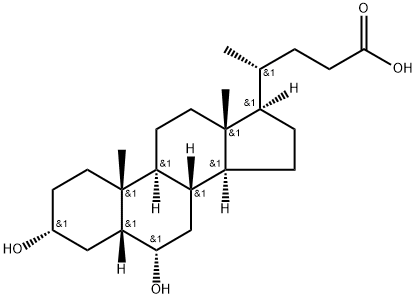
Hyodeoxycholic acid is a secondary bile acid formed by intestinal flora in the small intestine and is an agonist of TGR5 (GPCR19). In CHO cells, the EC50 value is 31.6 µM.
| Molecular Weight | 392.58 |
| Formula | C24H40O4 |
| CAS Number | 83-49-8 |
| Solubility (25°C) | DMSO ≥ 60 mg/mL |
| Storage | 4°C, protect from light, dry, sealed |
| Species | Mouse | Rat | Rabbit | Guinea pig | Hamster | Dog |
| Weight (kg) | 0.02 | 0.15 | 1.8 | 0.4 | 0.08 | 10 |
| Body Surface Area (m2) | 0.007 | 0.025 | 0.15 | 0.05 | 0.02 | 0.5 |
| Km factor | 3 | 6 | 12 | 8 | 5 | 20 |
| Animal A (mg/kg) = Animal B (mg/kg) multiplied by | Animal B Km |
| Animal A Km |
For example, to modify the dose of Compound A used for a mouse (20 mg/kg) to a dose based on the BSA for a rat, multiply 20 mg/kg by the Km factor for a mouse and then divide by the Km factor for a rat. This calculation results in a rat equivalent dose for Compound A of 10 mg/kg.
| Related Metabolite/Endogenous Metabolite Products |
|---|
| D-Thyroxine
D-Thyroxine is a thyroid hormone that can inhibit TSH secretion. D-Thyroxine can be used for the research of hypercholesterolemia. |
| Allolithocholic acid
Allolithocholic acid is a steroid acid could found in normal serum and feces. Allolithocholic acid facilitates excretion, absorption, and transport of fats and sterols in the intestine and liver. |
| Biliverdin
Biliverdin is the product of the oxidation of bilirubin. Biliverdin can be synthesized via a non-protoporphyrin pathway in Corynebacterium glutamicum. |
| Stachyose hydrate
Stachyose tetrahydrate is a functional oligosaccharide, acts as a prebiotic. Stachyose tetrahydrate can prevent indirectly colon cancer cell growth by promoting the proliferation of probiotics or producing beneficial materials in the intestine. Stachyose hydrate exhibit a hypoglycemic effect, and improve inflammation through modulating gut microbiota. |
| Stachyose tetrahydrate
Stachyose tetrahydrate is a functional oligosaccharide, acts as a prebiotic. Stachyose tetrahydrate can prevent indirectly colon cancer cell growth by promoting the proliferation of probiotics or producing beneficial materials in the intestine. |


Products are for research use only. Not for human use. We do not sell to patients.
© Copyright 2010-2023 AbMole BioScience. All Rights Reserved.
